Taking the Slow Road to the French Riviera
Caroline Mills saunters south to the Côte d’Azur for a road trip along the historic N7 Route des Vacances between Paris and Menton.
“Of all the roads in France and Europe, the one I prefer is the one that leads by car… to the shores of the South, Nationale Sept.” Like America’s Route 66, France’s Nationale Sept is one of the few roads in the world distinguished enough to have a song written about it. Charles Trenet’s 1955 jazz number Route Nationale Sept, with its tinkly bells and brush of the hi-hat, transports the listener into holiday mode, just like his most famous ballad, La Mer.
It all began with the Romans, who created a route between Paris and Rome via Lyon (then capital of the Gauls) that ran along the Mediterranean coast. The road was then upgraded in the 15th century when King Louis XI created the royal postal service, and it later featured in La Guide des Chemins de France by Charles Estienne, published in 1552.
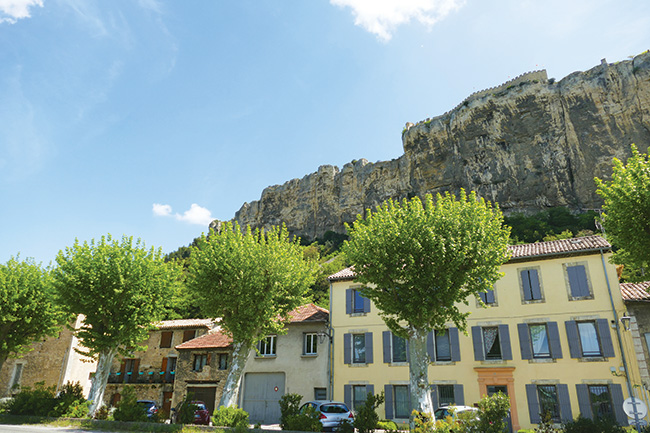
Spot the fortress, open to the public at Mornas
Fast forward to the 20th century, and the N7 achieved legendary status as the Route des Vacances, as wealthy Parisians emptied the capital on their way south. At its peak in the 1950s and 60s, the road was sometimes referred to as the Route de la Mort, courtesy of the notorious traffic jams on the annual summer dash to the Med.
Of course, with changing holiday habits and the advent of motorways, the N7 today is an altogether different experience, offering the chance to explore exceptional villages étapes (designated small villages and towns which are deemed to meet all a traveller’s needs), historic towns, and a wealth of attractions through ever-changing scenery.

The stunning Château de Fontainebleau © Shutterstock
I decide to take a spring road trip, picking up the route as it borders the River Seine in the outer suburbs of Paris. What greets me is a long, straight road but on a Saturday morning, it’s busy and the so-named Road of Death, when the N7 became clogged by Parisians collectively leaving the city, comes to mind. Happily, I’m soon crossing the Essonne River into countryside; the Forêt Domaniale de Fontainebleau is the first green lung through which the N7, now much quieter, passes. Beyond the 1,500-room Château de Fontainebleau, the first significant stopping point is Nemours, a town with an elegant 11th-century church and feudal castle on the grassy banks of the River Loing.
The road continues beside the river to Montargis, where I pull off at the first village étape of my journey, Ferrières-en-Gâtinais, an historic settlement which developed from the wealth of iron ore, as its name implies. Besides Ferrières-en-Gâtinais’ collection of charming stone houses along pedestrianised streets, there is an ancient abbey complex, a tiddly stream with wisteria-draped lavoir, buttercup meadows, hostelries and a campsite. Skirting Montargis, there are pretty views of the Loing river before the road continues through woodland (the far-eastern stretches of the Forêt d’Orléans). I peel off the N7 for the half-kilometre detour to the Château de la Bussière, where the turreted castle nestles amidst fine parkland, wildflower meadows, and oak and chestnut woods, as well as its designated Jardin Remarquable.
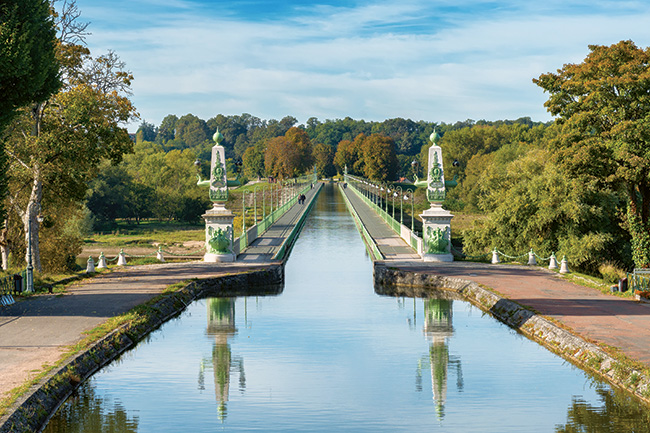
The stunning Briare Aqueduct, which carries the Canal latéral à la Loire over the river Loire, was the longest navigable aqueduct in the world until 2003 © Shutterstock
Through the Loire
Sixteen kilometres south, the route enters the Loire Valley at Briare, a handsome town situated on two rivers and a canal, just brimming with opportunities for messing about in boats. Not to be missed is the impressive and elegant 662m-long Briare Aqueduct.
At Cosne-Cours-sur-Loire, the A77 now supersedes the N7, so I cross to the left bank of the river for a detour to Sancerre. The hilltop town, renowned for its wines, is a worthy enough reason to head this way, but so, too, is the gentle potter along the D955, which runs beside the Canal latéral à la Loire. With wildflower-strewn banks beneath leafy hedgerows and a towpath for cycling, it’s an ideal place to break apart a baguette and nibble on a piece of cheese.
I return to the N7 (D907 at this point) at wine village Pouilly-sur-Loire. The iron-girder bridge across the river marks the ‘Middle of the Loire’ – it’s 500km either way to source and sea. Here the landscape is different from that in the Valley of Kings, and a walk through the Réserve Naturelle Val de Loire indicates, with interpretation panels, the importance of the river’s biodiversity. A further 11km south at La Charité-sur-Loire, the banks of the Loire offer up the perfect picnic spot. It’s also worth a wander into the town centre for a look at the Cluniac priory and church, a UNESCO World Heritage Site, and while you’re there, climb to the ruined ramparts to work off that picnic and be rewarded with excellent views.
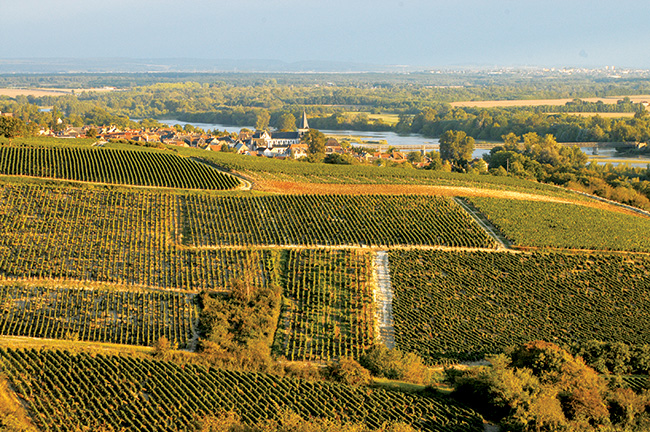
Head to Pouilly-sur-Loire for wine tastings © Shutterstock
I decide to skip the city of Nevers, the next significant stop along the N7 (the road at this stage is the A77), in favour of a rural detour on the D45 from La Charité to Apremont-sur-Allier. This quiet road follows the Canal latéral à la Loire again until it reaches the River Allier, a tributary of the Loire. Apremont-sur-Allier is one of the Plus Beaux Villages de France, with its château, Parc Floral, and stone houses prettily reflected in the river. Beyond Nevers (and Apremont), the N7 tours through the Allier valley, with open countryside and fields grazed by Charolais cattle. At Moulins, also on the Allier River, you can explore the Centre National du Costume de Scène, where you’ll find 10,000-plus stage costumes, including many from la Comédie-Française and the l’Opéra National de Paris.
Lapalisse, regarded as a notable village étape during the 1960s heyday of the Route des Vacances, is, with its formidable hillside château, still a desirable stop-off. It’s the last village along the N7 before the landscape changes; as the N7 turns southeast, it climbs into the brooding Monts de la Madeleine, before descending to Roanne, where the N7 meets the Loire once more.
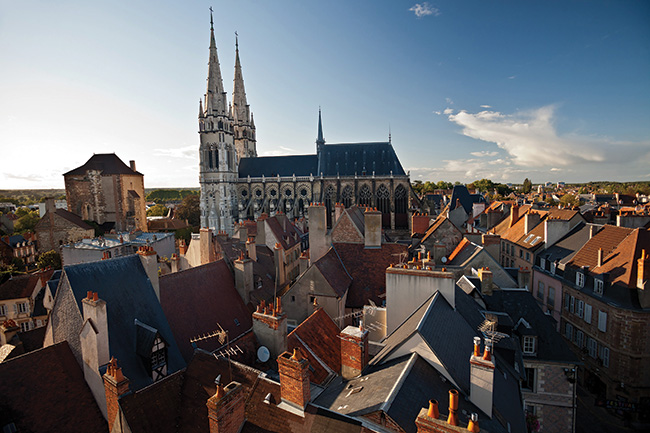
Visit charming Moulins © Shutterstock
Leaving Roanne behind, the route climbs again, into the lush hills of the Monts du Lyonnais, a rolling landscape of oaks, beech and pine forest interspersed with verdant meadows. There’s scenery aplenty to divert from the N7, including the gentle undulations of Beaujolais to the north. At 759m, the Col du Pin-Bouchain is the highest point along the N7 and is also geographically significant; its summit marks the border between the departments of the Loire and the Rhône and it is the watershed between rivers draining north to the Atlantic and those to the south flowing into the Med.
Historically, the Col is of interest as well: it is here in 1536 that King François I promised his daughter Madeleine’s hand in marriage to King James of Scotland. And in 1903 it became the first col ridden as part of the Tour de France. Cyclists today are advised to avoid it in favour of the valley routes, including through Joux, which looks more alpine Italian than Lyonnais. It’s tempting to head onto the motorway here (Tarare and Pontcharra-sur-Turdine have seen better days) but that would miss out L’Arbresle, which would never do. Amidst its golden stone buildings, you will spy Sainte-Marie de La Tourette priory, Le Corbusier’s last major work completed in France before his death. It is now a UNESCO World Heritage Site.

Cycling beside the River Saône in Lyon © Shutterstock
Approaching Provence
Navigating the streets of Lyon at rush hour is not, I suspect, what Charles Trenet was singing about as his ideal road trip. Neither was it mine and, while Lyon should be on an N7 ‘must-see’ list, in holiday mode the Rhône-side A7 through the city is easier. Once beyond Lyon, the N7 becomes a sprawling industrial estate for a few kilometres, with steamy puffs belching from the red and white chimneys of Roussillon’s chemical plant. But here, too, are the first fruit tree orchards with the foothills of the Ardèche as a backdrop. Further south, Saint-Vallier offers eye-level views of the Rhône before approaching the vine-studded hills around Tain-l’Hermitage. Beyond Valence, the N7 becomes Provençal, with cypress trees, bulging umbrella pines, florid Judas trees and wild herbs roadside.
The N7 skirts Montélimar, where nougat manufacturers once made their fortune by selling confections to road trippers en route to the Med. Artisan nougat makers, such as Arnaud Soubeyran directly on the N7, can still be visited to pick up sweet morsels for the journey.
Between Montélimar and Orange you’ll come to a perfect pair of villages étapes, Mondragon and Mornas, with their pale stone and pastel-shuttered houses and a castle apiece. The wooded hills behind Mondragon are an excellent place to stop for a picnic and stretch one’s legs on a walk among the vines and pines; at Mornas, gaze skywards at the fortress that sits camouflaged upon a cliff above the terraced village.
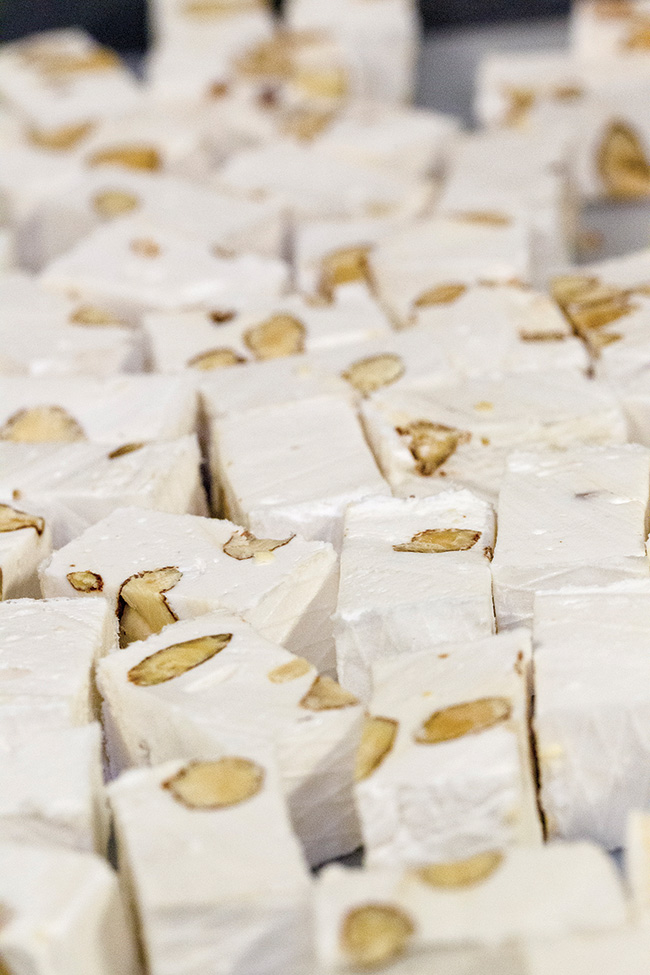
Fuel your journey with some delicious nougat from Montelimar © Shutterstock
Of all the fruits of Provence, the Romans’ presence is felt most keenly in Orange, with the Arc de Triomphe, encircled by the N7, and the enormous Roman amphitheatre that looms large. Little remains of Roman antiquities in Avignon, but the Palais des Papes and Pont d’Avignon are both remarkable ‘stop-gaps’ before arriving in the capital of the region, Aix-en-Provence, for a dose of art and culture. Thereafter, it’s the natural world that takes centre stage as the colossal slab of Montagne Sainte-Victoire, a Grand Site de France, shines silver in the sunshine, protruding sharply from rows of Côtes de Provence vines.
Wild iris and manicured lavender fields offer Provençal hues on the way to Fréjus and the first possible dip in the sea. I resist, eager for the wildest, most mountainous – and arguably prettiest – section of the N7, through the Massif de l’Estérel.
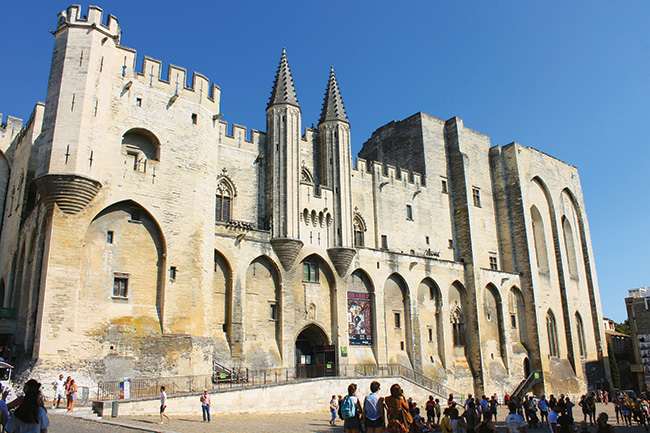
Learn more about the history of the area at Palais des Papes in Avignon © Caroline Mills
Immediately to the east of Fréjus’ suburbs, climb upwards into the Forêt communale de Fréjus, where the rugged landscape continues to the Col du Testanier, the highest point on the N7 within the massif. From here, pause to take in the immense views over to Mont Vinaigre, the highest peak in the Estérel.
Hiking boots laced, dusty red tracks draw me into the forest for a walk amid holm oaks, umbrella pines, strawberry trees, and explosions of perfumed wild lavender. A large lizard scurries beneath a rock, dipping momentarily out of warmth of the spring sunshine, while I pause for a sandwich with a view. The N7’s descent to Mandelieu-la-Napoule is a marked contrast from the climb. With an open aspect before me, the road twists and turns beneath a canopy of cork oaks, their trunks skinned and bare. Houses thrust upwards out of the woods on any surface that isn’t true-vertical.
At L’Escaillon, I am rewarded with my first sight of the sea – a view of the bay at Cannes and the Îles de Lérins. It’s an exciting moment before my descent to sea level. The N7 (now the D6007) slips behind the row of grand hotels in Cannes au bord de la mer, with tantalising glimpses of azure water and parasols. It’s not until the route has bypassed Cap de la Croisette that it reaches the sea for an all-too-brief rendez-vous at Golfe-Juan before it darts inland again to cut through Antibes.

Plage des Marinières at Villefranche-sur-Mer © Shutterstock
The Glittering Coast
Lured by the sparkling water, I divert onto the coast road at Juan-les-Pins to Cagnes-sur-Mer and Nice. Here, the N7 (now the M6077) becomes a three-lane Voie Rapide above the city rooftops. To the east of Nice, it climbs the Moyenne Corniche, a road that provides lavish views of the coastal beauties of Saint-Jean-Cap-Ferrat, Villefranche-sur-Mer, Èze, Monaco and Cap-Martin.
Then, suddenly, with the local école discharging its flock into the thronging streets, Roquebrune-Cap-Martin becomes Menton. With almost 1,000km on the clock, the vibrant colours of France’s border town are like a refreshing citrus burst. As I climb above the dome of the basilica to Cimetière du Vieux Château for the best view in town, residents are returning home after their day’s work. A group of school children let off steam in the Baroque courtyard of the basilica. Counting in Italian, eyes squeezed tight, their faces are pressed to the church walls as friends hide: uno, due, tre, quattro, cinque, sei, sette. Yes, I thought, number seven. What a road trip. What a finale. Boum!
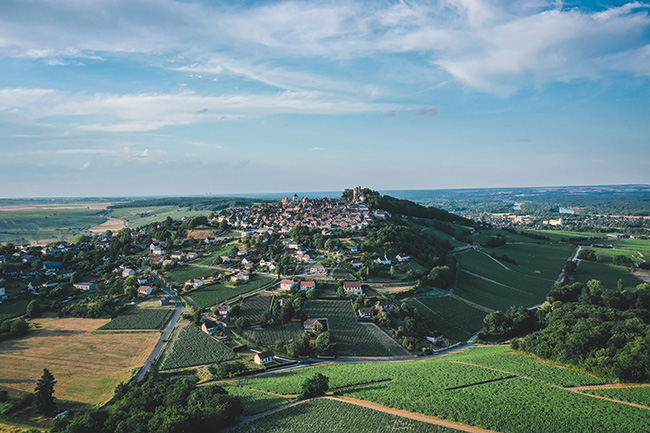
Sancerre, renowned for its wine, is well worth a detour – leave room in the boot for a few bottles direct from the vineyards © Shutterstock
Food and Drink
Wine-lovers touring the N7 are spoilt with a vineyard crawl from the southern Loire Valley (Sancerre, Pouilly-sur-Loire, and the lesser-known Côtes de la Charité) to Beaujolais, Côtes du Rhône (including Crozes-Hermitage, Châteauneuf-du-Pape, and Saint-Péray close by) to Coteaux d’Aix-en-Provence, Coteaux Varois en Provence (around Brignoles) and the Côtes de Provence.
Stop by La Maison des Sancerre, in the village centre; the Cave de Tain in Tain-l’Hermitage, the co-operative of 280 vignerons from the Côtes du Rhône; and the Maison des Vins Côtes de Provence, directly on the N7 at Les Arcs, which represents more than 800 regional wines. Lyon is considered France’s gastronomic capital and there are numerous not-to-be-missed foodie experiences throughout the city, from guided walks to food festivals and cookery workshops. Be sure to eat out at a traditional bouchon for an authentic Lyonnais culinary experience.
From France Today magazine
Lead photo credit : The Route des Vacances leads to glorious Menton © Shutterstock
Share to: Facebook Twitter LinkedIn Email
More in cote d'azur, France’s Nationale Sept, French Riviera, Menton, Provence
Leave a reply
Your email address will not be published. Required fields are marked *

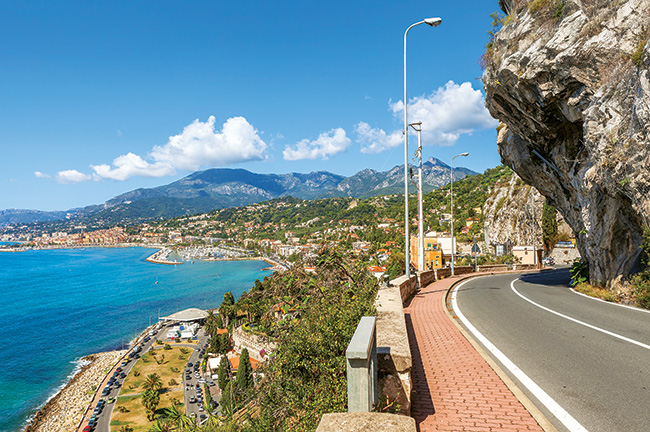


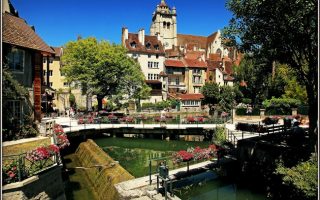
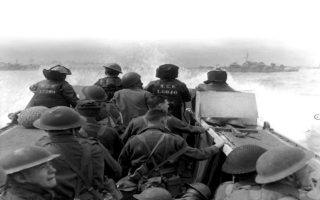
REPLY
REPLY
REPLY
REPLY